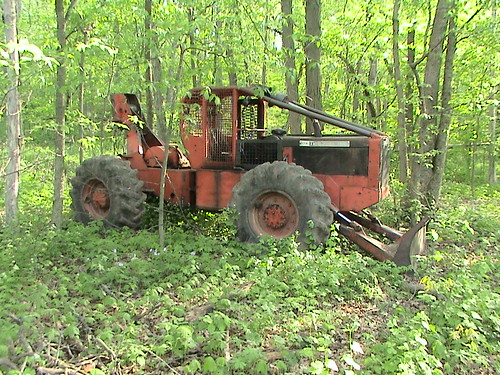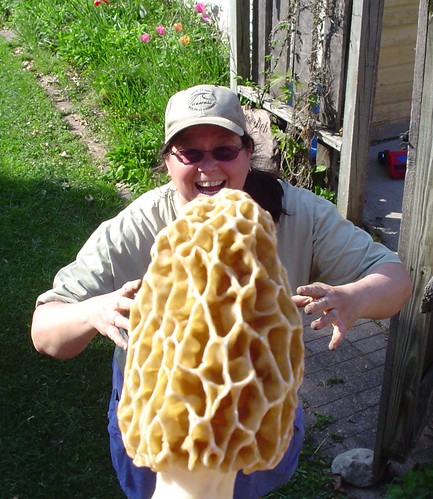I went to Monroe today to saw an 8' Elm log and an 8' White Oak log into boards on the band saw. Albert bought a used Wood-Mizer portable band saw mill many years ago. Occasionally, I've had the opportunity to mill my own logs. It's quite remarkable to turn a log into boards.
I cut the Elm first and all went well until I tried to lower stops. I couldn't remember which control moved them and opted for the "Toe board" control. This was not correct as the toe board control moved the "toe board" up which moved the log up and pinched the blade. I tried to move the toe-board down, but moving the control lever down only moved the front toe-board up. This was worse. Luckily, I had stopped the blade and there was enough give that it was not snapping. While I was trying to find a way to lower the toe boards, Steve stopped by and I explained the problem. He showed me where there was a toe-board release valve the removed the pressure from the toe-boards and they lowered, FINALLY. Then, we wedged the partially cut top board from the rest of the log and moved the saw blade back out of the log. It took some trial and error with the controls to find the one that did lower the stops. Steve finally got it with the turning control. Once the turning arm is all the way lowered the control moves the stops down also. Finally, I could move the stops and the clamp out of the way of the blade and I had not ruined the blade.
I finished the Elm and started on the White Oak. Steve asked if I wanted to cut some Basswood too while I was there. I said no, but later changed my mind and cut a Basswood log, too. The White Oak log went well, but White Oak is noticeably harder wood based on how slowly I needed to move the saw while cutting these boards.
Just as I was getting good, the saw stopped. I was out of gas! Jason had said there should be enough gas to finish. But, he hadn't accounted for how much time the saw was running while I was considering my options and turning the log to a new side and playing with the controls, etc. Anyway, I went to lunch while I waited for Jason to return to confirm which gas I should use to refill the tank.
After lunch, Jason returned and we filled the gas tank. I told him I might get to cutting the Basswood log. So, he and his kids got the tractor and brought the log over. I continued to cut the White Oak and all went well until I forgot to put the clamp down. I ran the blade (luckily not a sharp blade by this point) into the metal of the clamp and saw sparks fly. I stopped immediately, but it was too late the blade would not cut wood any longer. At least Jason had walked me through changing the blade before he left and I was able to do this without too much hassle. Getting the huge blade into three small loops was the hardest part.
After the blade change, I finished cutting the White Oak log and then moved the Basswood log on to the loader legs. Lifted it on to the cutting deck and after a simple turn, I set the clamp and was ready to cut. Cutting the Basswood boards was a breeze as compared to the White Oak boards. They cut like "butter". Once again, the difference between hard wood and soft wood is obvious. I cut the basswood into very small boards as I intend to give it to kids to build with and they like the smaller easy to handle pieces.
After a little air drying, I'll pick up the Basswood boards. As for the White Oak and Elm, I'll let them dry a little longer. Maybe, get the Elm milled into tongue and groove paneling. Or, make some shelves, or other.
Saturday, September 19, 2009
Wednesday, May 27, 2009
Buckthorn Removal and Mushroom News
I found a very informative forum on removing Buckthorn at: forums.gardenweb.com and this Buckthorn control page on MN DNR web site.
Quick summary of the recommendations on the forum: Use Garlon 3 (full-strength) or Garlon 4 1:4 (w/diesel fuel) in Oct, Nov, or Dec on cut stumps of buck thorn.
Randy emailed me that he found 4 1/2 pounds of morels on the 19th. We were definitely looking on the right day (the 12th). Too bad we weren't looking in the right place.
Quick summary of the recommendations on the forum: Use Garlon 3 (full-strength) or Garlon 4 1:4 (w/diesel fuel) in Oct, Nov, or Dec on cut stumps of buck thorn.
Randy emailed me that he found 4 1/2 pounds of morels on the 19th. We were definitely looking on the right day (the 12th). Too bad we weren't looking in the right place.
Tuesday, May 26, 2009
WISCONSIN LOCAL-USE DIMENSION LUMBER GRADING
I found a DNR newsletter with information about the creation of a short-course and examination that small sawmill operators can complete to be able to grade lumber for local-use. Wisconsin Wood Marketing Bulletin Oct-Dec 2008.
Unfortunately, the deadline for registering for the June 16th course passed on May 11th, 2009. So, we'll have to wait for the next round of courses to get someone certified in this way. It would be good to get on the mailing list for this newsletter to get this information more timely.
The Wisconsin Statute that governs this certification process and use is found at 101.66 of this document: Stat0101.pdf. Search for 101.66 and 101.977 to read the statute regarding allowable sales and certification requirements.
Unfortunately, the deadline for registering for the June 16th course passed on May 11th, 2009. So, we'll have to wait for the next round of courses to get someone certified in this way. It would be good to get on the mailing list for this newsletter to get this information more timely.
The Wisconsin Statute that governs this certification process and use is found at 101.66 of this document: Stat0101.pdf. Search for 101.66 and 101.977 to read the statute regarding allowable sales and certification requirements.
Saturday, May 23, 2009
Harvest 2009

Steve called to say he was going to be working in the timber on Saturday from 1:30-5:00pm and I got down to the timber a little after 4pm. Basically, I was just in time to meet him pulling the last load out for the day. My timing was perfect. I got to take some photos of the logs, talk to Steve, and see the new logging road that exists.
It's mostly White Oak logs with a few Black Oak and Elm logs too. Some over 20 inches, but a lot more in the 16 to 18 inch diameter. A few 20 foot lengths, some 16 foot length, and less. Check out my harvest slide show to see more.
Sunday, May 17, 2009
Some Saw Logs
 Tajenay and I went to the timber to find morels. We found lots of garlic mustard and two piles of saw logs. Steve has definitely been busy. We counted 21 logs in one pile near the stream and 11 more in the pile closest to the tractor. Mostly White Oak with several 16 ft logs and as many 8, 10, or 12 ft logs. The diameters ranged from 10 inches to almost 20 inches inside bark.
Tajenay and I went to the timber to find morels. We found lots of garlic mustard and two piles of saw logs. Steve has definitely been busy. We counted 21 logs in one pile near the stream and 11 more in the pile closest to the tractor. Mostly White Oak with several 16 ft logs and as many 8, 10, or 12 ft logs. The diameters ranged from 10 inches to almost 20 inches inside bark.But, we found no mushrooms... well, one mushroom, but it was not a morel and we just took a photo home, not the mushroom. I pulled a lot of garlic mustard, but it's already gone to seed so I think it's too late to try garlic mustard pesto.
Tajenay loves playing in the water and we stayed until 5:30pm when the mosquitoes started to bite. A wood duck landed right near the crossing, then saw us and took flight downstream. Tajenay saw hand prints made by little moo cows (a.k.a. "she saw deer tracks").
It was another great day in the timber with no real timber work getting done. Our to do list: cut and treat the wahoo (burning bush) by the stream, transplant the black walnut trees (that are growing in our yard) to the timber, cut maple and basswood trees that have started to win the understory, cut back buck thorn and raspberries bushes to make easier travel, create some walking trails, and hire an army to pull garlic mustard.
Tuesday, May 12, 2009
Our First Morel
 Last Sunday Lynne, Tajenay and I searched with our friends Shirley and Diane for morel mushrooms, but found none. We did enjoy a great day in the woods and saw black-cherry blossoms, lots of wild-flowers including: may-apples which were out with buds but no blooms, "trout-lilys" everywhere but only a few had shooting star blooms, no trillium, but a few jack-in-pulpits had their hoods started
Last Sunday Lynne, Tajenay and I searched with our friends Shirley and Diane for morel mushrooms, but found none. We did enjoy a great day in the woods and saw black-cherry blossoms, lots of wild-flowers including: may-apples which were out with buds but no blooms, "trout-lilys" everywhere but only a few had shooting star blooms, no trillium, but a few jack-in-pulpits had their hoods started  , and many purple and yellow violets. Unfortunately, so was the garlic mustard.
, and many purple and yellow violets. Unfortunately, so was the garlic mustard.Today, Lynne and I went again and much to our dismay, we found large areas of garlic mustard blooming and choking out everything they could. We jumped from one dead elm to another trying to find a morel. After about 20 minutes, we found it. One perfect morel mushroom poking up from bare dirt. It was only one, but it was huge (see photo). It was a couple of feet from a small dead elm on a north-facing slope and about four feet from a large dead elm. No may-apples right at that spot, but lots of may-apples with blossoms nearby.
We were sure we would find more mushrooms after finally finding one. But, it was not to be. We stayed for about two hours and never found another morel. We did find lots more violets (purple, yellow, and white), and Soloman's seal, as well as several fairly large Jack-in-the-Pulpits. The honey-suckle has small leaves now, and the burning bush too. It would be a good time of year to try and get those cut back. If only I wanted to work instead of look for mushrooms.
We did do some work though as we threw many small and large rocks back to the stream crossing that we want to keep for getting to the back of the timber.
Subscribe to:
Posts (Atom)